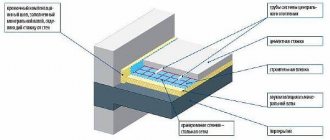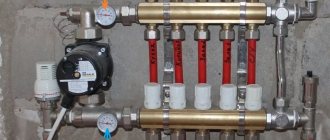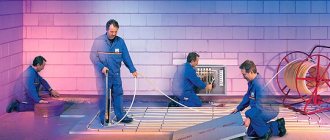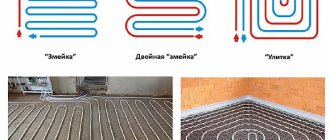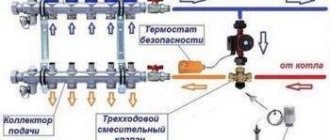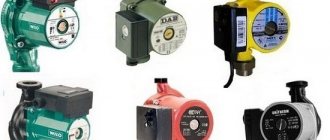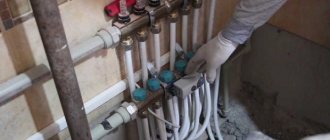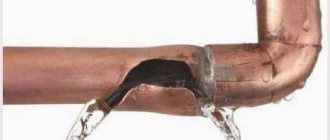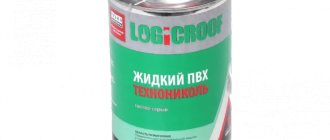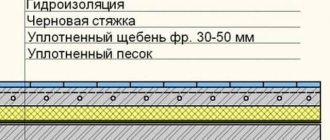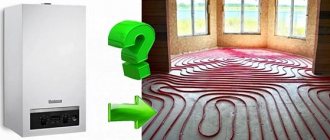The collector in the heated water floor device serves to adjust the temperature in the coolant. Heating, which occurs by a boiler with parameter adjustment using programs. Standard heat indicators are 55 degrees Celsius, so that the comfortable temperature of the heated floor is 30 °C.
If the system has a mixing unit that can independently regulate the high temperature supply by adding cold water.
But when installing a heated floor without a collector, hot water must flow at the required temperature ; accordingly, this requires the installation of a separate boiler in the system.
An individual radiator floor heating option requires a second boiler or connection to central heating. The average heat standards in batteries are 69-79 degrees Celsius. And this is 20 degrees more than the recommended heat for heated floors.
Features of connecting a heated floor without a mixing unit
A common mistake when installing a system without a mixing unit is installation in a very large room.
Basic installation requirements:
- The walls in the room must be insulated (outside or inside);
- The floor must be insulated;
- High-quality double-glazed windows;
- Installation of the floor close to the heating system;
- The area of the room is no more than 25 m2.
Disadvantages of a system without a collector:
Large heat losses along the path from the heating device and the pipeline unit itself. Accordingly, it is necessary to conserve heat on the floor surface.
A competent calculation of the length of the circuit and circuit is necessary so that the return temperature indicator is not too low. Otherwise, during the heat exchange of the boiler, a lot of condensate will form, which can quickly damage the device.
Installing a condensing boiler with high efficiency helps with cold “return”; the device is not affected by low temperatures when heating.
Assembly methods
The elementary principle of assembly is to connect the underfloor heating structure to the central heating. The disadvantage of such a system is the risk of breakdowns of the underfloor heating pipeline due to the supply of high water temperature to the radiators.
A self-built structure that is connected to a central heating point may be fined and dismantled by supervisory authorities upon detection.
The two best ways to lay pipes without a mixing unit:
- the snake helps distribute heating areas (bypass furniture or plumbing fixtures);
- The snail promotes uniform heating of the floor area.
Both methods must be constructed of a double piping system for supplying and returning water.
After the pipeline is laid, it is connected to the boiler. A pump of the required power will ensure the speed of movement of the heating element through the pipeline.
Pump models come in manual and automatic control . The device is placed on the supply part of the pipe. If there is no collector in the system, the pump is located under the boiler.
The connecting structure is completed by a valve, which should be installed between the pipe and the pump.
For stable operation of a heated floor without a collector, it is recommended to choose a high-quality electric or gas boiler with high power.
It is better to purchase a boiler complete with a pump .
Differences between radiator heating designs and water heated floors
- Radiator heating is characterized by high coolant temperatures, the supply temperature is approximately 70 degrees, and the return temperature is 50 °C. Installation features - the pump is not installed on the supply side to eliminate the possibility of overheating.
- The floor temperature during heating should be no more than 26-30 °C; a comfortable temperature for gentle operation of the pump is 40 °C.
- The circulation speed of radiator heating is not high; due to the temperature difference, it will be enough to install a boiler with a pump built into it.
- Thin plastic pipes serve as a radiator for a warm water floor. The length of pipes can reach more than one hundred meters in one installation system. Accordingly, the pumping device must be powerful in order to push water through the pipeline.
Three way valve system
The thermostatic valve (three-way) is assembled onto the heat supply pipes, and a jumper is connected to the opposite flow.
This device regulates the temperature of the heat supply, which is supplied to the pump. The valve functions as a mixer with a temperature-sensitive element.
The advantages of the valve are that it protects the system from too high temperatures (overheating) and, if necessary, during a breakdown it will automatically shut off the supply of coolant and return flow. Thanks to this, the valve takes on part of the work of the mixing unit.
When the floor area is too large, large heat losses can occur when the coolant returns. Therefore, it is better to install a valve on the edge with a cold inlet; this will give the effect that there is no excess condensate in the heat exchange device.
Choosing a pump
Is it possible to do without a mixing unit? It's possible, but it's unlikely without a pump. The circulation station will increase the pressure and heat the water evenly, will not create excess pressure, and will push the water at the required speed.
Before choosing a pump, you need to decide on the company, model, and material from which it consists.
For use in domestic conditions, it is recommended to use two types of equipment:
- Glandless rotor pump . This technique does not have much power, but can provide heated floors with an area of 350-400 m2. The rotor is called “wet” because the wheel is located in the coolant; cooling and lubrication occurs when it is used. The device is popular due to its quiet operation, reliability and economical energy consumption.
- The model with a dry rotor is a fairly powerful device in which the rotor is located in an impenetrable container. This type of equipment is used for arranging fountains in private homes or park areas. The model requires periodic maintenance.
Pump installation
The pump must be installed so that the rotor is horizontal. Vertical installation will not affect the duration of the operating period and the performance of the unit. But you shouldn’t expect the power indicated in the technical data sheet. Losses can be up to 30%. And this is quite a lot.
It is advisable to install the pump on the supply pipe. It should be located after the mixing unit.
But these provisions are not fundamental. Some pump connection diagrams assume its location on the return pipe. If the water floor system is located in a house with several floors, then several pumps need to be installed. It is advisable to equip each level with a device. This will make the system more manageable.
Related article: Guides for sliding doors - rollers and sliding systems
Common mistakes
Most common mistakes made during installation work:
- The pipes were poured into the floor and they forgot about insulation. A foil backing is not suitable ; it is better if it is foamed polystyrene. Otherwise, half of the heat will go to heating the floors or the ground.
- Installation is carried out only under tiles (with the exception of electric heated floors). When professionally assembled, buildings with a thick layer of coating on the floor can be heated.
- The heated floor structure is connected to the boiler without a mixer. This is a necessary part that maintains the temperature to power the system.
- Laying metal-plastic pipes in a snail pattern in all rooms.
Different rooms require different installation approaches. For example, a pipe that runs from the outer walls at a distance of 40-80 cm must be installed tightly to compensate for heat loss.
Connection options
To ensure normal operation of the TP circuits and get the long-awaited feeling of comfort, it is necessary to resolve 2 issues:
- Supply coolant with a temperature of no higher than 50 °C (maximum 55 °C) into the heating circuit pipes. Overheated floors cause discomfort for most people; the optimal temperature for finishing is 26 °C.
- Ensure the required coolant flow in radiators and underfloor heating loops. If the diameter of the supply line is too small or the circulation pump does not develop the required performance, the radiators and heated floors will heat equally poorly.
Let's look at several schemes that allow you to connect a water-heated floor to an existing heating system. Let's see how well the issues of temperature and coolant flow are resolved in each option:
- direct connection to a two-pipe radiator network;
- the same, using regulating thermostatic heads;
- insertion into the main line of a single-pipe system with an additional pump;
- full connection with a separate pipe from the boiler.
Direct connection to the radiator network
The insertion of the TP circuit into the supply and return of a two-pipe distribution will function tolerably under the following conditions:
- the total heated area is relatively small - up to 100 square meters;
- heat source – gas boiler capable of maintaining the coolant temperature within 40-50 °C;
- the circulation pump installed in the boiler room has sufficient performance;
- heated floors are designed for heating small rooms - bathroom, kitchen, children's room.
The direct connection scheme is suitable only for small heating areas
The direct connection scheme has a right to life, but in general it is very imperfect. Judge for yourself: it is much easier for water to move along a path of low resistance further along the main line than to flow into a long pipe of the heating circuit.
Point two: when severe cold weather sets in, you yourself will raise the temperature in the boiler, the floor surface will heat up and the room will become stuffy. The tiled bathroom will turn into a bathhouse. Please note: intensive heating of the bathroom is absolutely useless; people are not there all the time.
Option for direct insertion of the circuit instead of a dead-end radiator with two-pipe wiring
For reference. As some home craftsmen also do: they connect the TP circuit to a break in the return line running from the batteries to the heat source. And then they wonder why the heated floors and radiators don’t work. The reason is an increase in the hydraulic resistance of the entire branch and a decrease in coolant flow.
Using RTL valves
Special thermal heads of the RTL type will directly help to correctly solve the issue of regulating the water temperature when connecting a heated floor. An automatic valve is installed on the return pipeline and can be easily adjusted to a certain temperature. The work algorithm looks like this:
- Until the heating of the coolant reaches the value set on the thermal head, it quietly circulates through the pipe of the floor circuit.
- When the water temperature rises to the set value, the head actuator closes the thermostatic valve. The circulation stops and the coolant cools down.
- After the temperature decreases as a result of cooling, the thermostat opens the passage and the movement of water resumes.
Heating is regulated based on the temperature of the return flow limited by the thermal head
Reference Information. The European company Oventrop has long been offering solutions for such cases - UniBox blocks built into the wall. There is an RTL type thermal head inside, the adjustment handle is brought out. There are versions with two valves - one controls the coolant flow based on the return flow temperature, the second controls the heating of the surrounding air.
The disadvantage of the solution is the limitation of the pipeline length. If the length of the loop exceeds 50 m, the transformer transformer will begin to operate unevenly due to increased resistance. To heat medium and large rooms, you will have to divide the heated floors into 2-3 circuits and the same number of monoliths separated by expansion joints, as shown in the drawing.
Now about the pros:
- heating with heated floors can be organized in any room, without being tied to the boiler and furnace;
- the price of the product is incomparable with the cost of mixing units and additional pumps;
- if the batteries are equipped with air thermal heads, the TP system will be able to operate in the summer - the radiators will turn off themselves.
The described scheme is also suitable for connecting underfloor heating to a two-pipe centralized heating network. But keep in mind one nuance: dirty coolant can quickly clog the thermostatic valve or damage it. The master will tell you about the intricacies of the operation of RTL heads in the next video:
Is it possible to connect to a single-pipe distribution?
In order to power the heated floors from heating - the single-pipe "Leningrad" favorite of many craftsmen - you will have to assemble the mixing unit with your own hands and install a second pump, as shown in the diagram. For the normal functioning of the system, the following conditions must be met:
- the internal diameter of the distribution line is at least DN25, the maximum number of radiators on the ring is 5 pieces;
- the connection of the TP loop is made into the return pipeline after all batteries;
- the minimum distance between the supply and return taps of the heated floor is 30 cm;
- To maintain the temperature in the circuit, a three-way mixing valve is installed.
Note. A similar scheme is used by apartment owners to unauthorizedly connect TPs to the old type of central heating - single-pipe vertical risers.
In this and other diagrams, shut-off valves and automatic air vents are not shown, but it is necessary to install these fittings
The three-way valve is of a simplified design, capable of preparing water at a fixed temperature of 45-50 °C. The pump “drives” the coolant through the loop, and the valve mixes in portions of hot water from the main line.
In practice, the scheme is used quite rarely. The reason is instability of operation and imbalance of radiators connected to a single pipe of the Leningradka. When the three-way valve opens slightly and recharges the heating circuit, the pump pressure is transferred to the main line, and the water flow in the batteries changes.
Advice. If you want to assemble a reliable underfloor heating system, it is better to install separate supply and return pipelines from the boiler. The consequences of perversions with a single-pipe radiator network are unpredictable.
Traditional scheme with mixing unit
When it is necessary to install underfloor heating in each room of a two-story house, you cannot connect to the existing radiator heating - you need to lay separate pipelines and install a distribution comb. What connection options are used:
- if the length of the circuits does not exceed 50 m (including connections to the collector), thermal heads are installed on the comb that respond to the return flow temperature;
- mixing unit with manifold and two-way valve;
- the same, with a three-way thermostatic valve.
In the first case, the principle of operation is similar to inserting one loop through the RTL head, only the regulators are located on the comb and control each circuit separately, as is implemented in the photo. Circulation is provided by the main pump located in the combustion chamber or inside a wall-mounted gas boiler.
In the second option, hot water is mixed by a two-way valve installed on the supply and controlled by a thermal head with an external temperature sensor. The latter is hidden in the collector pipe or screwed to it from the outside.
When the temperature of the supplied coolant increases, the liquid from the sensor flask presses on the valve stem and it closes. The scheme provides for the installation of an additional pump that pumps water through all loops of the TP.
The scheme with a three-way valve, whose operating principle is described above, is more advanced and is designed for a significant flow of coolant in heated floors. The disadvantage of both options is the high price of the equipment and the complexity of installation. All details about assembling the comb and how to connect the heating circuits are set out in the corresponding manual.
Conclusion
The installation scheme for a heated floor is selected based on the area of a specific room, based on the heating option. Laying pipes with a snail is a universal and economical way to heat a room in any weather conditions.
The longer the plastic pipes are, the more powerful the pump should be. After all, you will need good pressure and the need to overcome large hydraulic resistance.
It is better to purchase and install adjustable pumps that have three speeds.
Trouble-shooting
The quality of tap water, namely the water used in the underfloor heating system, leaves much to be desired. Some time after using the pump, salts are deposited on its elements in contact with water. If the pump runs continuously, there will be no problems. In the summer months, the heated floor is usually turned off.
And so, after trying to turn it on, problems begin. The pump simply refuses to “pump water”. At the same time, it hums, which indicates the operating condition of the unit. The coolant does not enter the system because the rotor cannot turn. It is necessary, using available means, to rotate the impeller two or three times. If the unit does not start working, then you need to contact a specialist.
When choosing a pump for a heated floor, you need to pay attention to many factors: type of equipment, country of origin, parameters, functionality, etc. If you approach the choice with a certain degree of negligence, the system may not work as desired.
